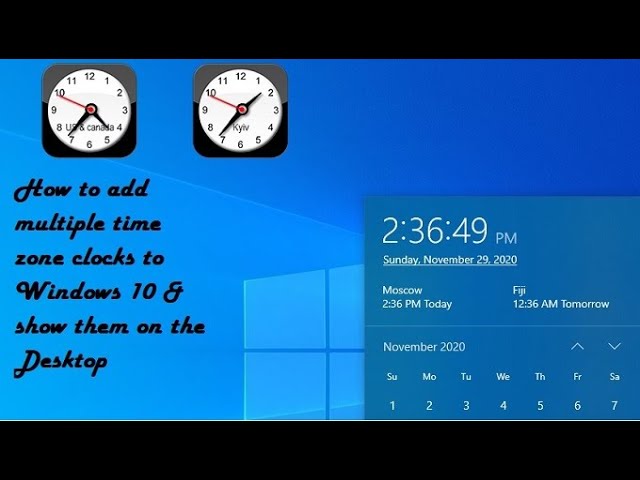Mastering Time: A Comprehensive Guide on How to Add Clocks from Multiple Time Zones in Windows 10

Introduction:
In our interconnected and globalized world, the ability to keep track of time across different time zones is crucial for effective communication, collaboration, and coordination. Windows 10 recognizes this need and provides users with a feature that allows them to add clocks from multiple time zones directly to their taskbar. In this extensive guide, we will explore the intricacies of adding clocks from multiple time zones in Windows 10, shedding light on the benefits, step-by-step procedures, and customization options available to users seeking a more synchronized and efficient approach to time management.
Understanding the Significance of Multiple Time Zone Clocks:
The incorporation of multiple time zone clocks in Windows 10 caters to the diverse needs of users who collaborate with colleagues, clients, or friends from different parts of the world. This feature enables users to quickly and easily check the time in various locations without the need for external applications or online tools. Whether you’re a business professional scheduling meetings with international teams or a traveler coordinating with friends across continents, the ability to add clocks from multiple time zones streamlines your timekeeping experience.
Benefits of Adding Clocks from Multiple Time Zones:
- Global Collaboration: For professionals working with international teams, the ability to quickly reference multiple time zones fosters efficient communication and collaboration, minimizing scheduling conflicts.
- Travel Coordination: Travelers can benefit from the convenience of monitoring the time in their home location and the destination simultaneously, aiding in travel planning and staying connected with loved ones.
- Family and Friends Abroad: Individuals with family and friends living in different time zones can stay informed about their loved ones’ local time, making it easier to schedule calls, video chats, and virtual gatherings.
- Meeting and Event Planning: Event organizers and planners can efficiently coordinate activities, meetings, and virtual events across different time zones, ensuring that participants are aware of the schedule in their local time.
- Business Transactions: Professionals engaged in international business transactions can use multiple time zone clocks to monitor market hours, plan transactions, and stay informed about the timing of critical financial events.
Adding Clocks from Multiple Time Zones in Windows 10:
Windows 10 provides a straightforward method for adding clocks from multiple time zones to the taskbar. Follow these step-by-step procedures to enhance your timekeeping capabilities:
- Access Date and Time Settings: Right-click on the system clock in the taskbar and select “Adjust date/time” from the context menu.
- Go to Additional Clocks: In the Date & time settings window, navigate to the “Additional date, time, & regional settings” link. This will open the Control Panel.
- Access the Additional Clocks Tab: In the Control Panel, click on “Clock and Region” and then select “Date and Time.” Go to the “Additional Clocks” tab.
- Enable Additional Clocks: Check the box next to “Show this clock” to enable the feature. You can add up to two additional clocks in addition to the main system clock.
- Select Time Zone and Provide a Display Name: For each additional clock, choose the desired time zone from the dropdown menu. Also, provide a display name that will help you easily identify the clock, such as the city or region associated with the time zone.
- Apply and OK: Click “Apply” and then “OK” to save the changes. The additional clocks will now be displayed when you hover over the system clock in the taskbar.
Customization Options for Multiple Time Zone Clocks:
Windows 10 offers several customization options to tailor the appearance and behavior of multiple time zone clocks:
- Choose Analog or Digital Display: In the Date & time settings, you can choose between analog and digital displays for the additional clocks. This allows users to select a format that aligns with their preferences.
- Customize the Clock Names: When adding additional clocks, customize the display names to provide clarity and make it easier to identify each time zone.
- Order of Display: The order in which the clocks are displayed can be adjusted. Click and drag the clocks in the “Additional Clocks” tab to change their order, helping users prioritize the most important time zones.
- Set the Correct Time Zone: Ensure that the correct time zone is selected for each additional clock to accurately reflect the local time in the chosen region.
- Adjust for Daylight Saving Time: Windows 10 automatically adjusts for daylight saving time, but users can double-check and ensure that the option is enabled in the Date & time settings for accurate timekeeping.
Conclusion:
Adding clocks from multiple time zones in Windows 10 is a valuable feature that caters to the needs of global citizens, professionals, and collaborators. By following the step-by-step procedures outlined in this comprehensive guide, users can effortlessly enhance their timekeeping capabilities, fostering efficient communication and coordination across different regions. The ability to monitor multiple time zones directly from the taskbar streamlines various aspects of daily life, from business collaboration to international travel planning. Embrace the convenience of multiple time zone clocks in Windows 10, and master the art of global time management in the digital age.







